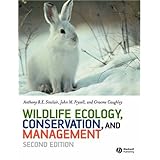
Average Reviews:

(More customer reviews)Are you looking to buy Wildlife Ecology, Conservation and Management? Here is the right place to find the great deals. we can offer discounts of up to 90% on Wildlife Ecology, Conservation and Management. Check out the link below:
>> Click Here to See Compare Prices and Get the Best Offers
Wildlife Ecology, Conservation and Management ReviewAre you studying at the graduate and undergraduate level in the area of wildlife management and conservation? If you are, this book is for you! Authors Anthony R. E. Sinclair, John M. Fryxell and Graeme Caughley, have written an outstanding 2nd edition of a book about how conservation has become an increasingly important component in the management of animal populations and their habitats.Sinclair, Fryxell and Caughley, begin with an explanation about what wildlife management is, how it relates to conservation, and how it should operate. Then, they provide a brief overview of the main ecological divisions in the world and supply a background of natural history. The authors continue by outlining the mechanisms by which the evolutionary process of speciation , convergence, and radiation come about. In addition, they also discuss food and nutrition. The authors also consider how ecological constraints shape the behavior of individual organisms and, conversely, the effect of individual behavior on the dynamics of populations and communities. Then, the authors deal with the internal workings of a population that result in a change of population size. Next, they explore some of the reasons why populations are found where they are. Then, the authors describe the theory and evidence for the stability of populations through regulations. Next, they review the competition and facilitation between species. The authors continue by describing the behavior of predators with respect to prey. They also introduce parasitism and disease within wildlife populations. In addition, they also explore those things an animal needs to eat to survive and reproduce resources. Next, they deal with the counting of animals. Then, the authors explore age and stage structures. Next, they explore the methods for choosing between such alternative models or hypotheses. The authors continue by explaining how a technical judgment can be evaluated, by posing it as a question. They also deal with theory that has been developed to account for why and how populations become extinct. In addition, they review actual extinctions or near extinctions to show what are the commonest causes of extinction in practice. Next, the authors consider how to estimate an appropriate offtake for a wildlife population. Then, they show you how a control operation is similar to a sustained-yield exercise but is conceptually more complex. Finally, the authors put the various aspects that they have discussed throughout the rest of the book into the context of the ecosystem to show how these are pertinent to management and conservation.
The authors have also provided a CD that illustrates in close detail how to calculate most of the mathematical concepts discussed in this most excellent book, including all of the simulation models. To further the development of problem-solving skills, the authors also included a series of computer labs, touching on several key concepts.
Wildlife Ecology, Conservation and Management Overview
Want to learn more information about Wildlife Ecology, Conservation and Management?
>> Click Here to See All Customer Reviews & Ratings Now
0 comments:
Post a Comment